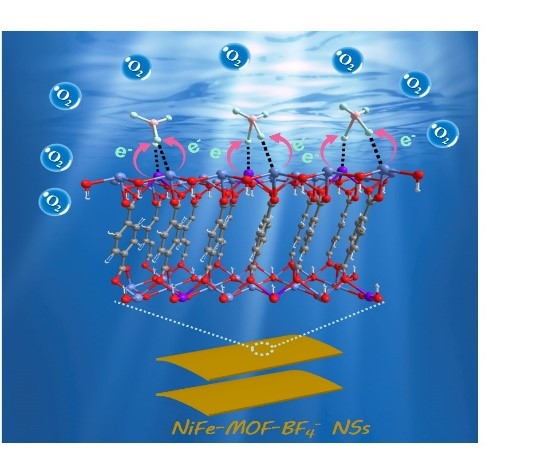Engineering the Electronic Structures of Metal–Organic Framework Nanosheets via Synergistic Doping of Metal Ions and Counteranions for Efficient Water Oxidation
Zhong-Yin Zhao , Xiaoxu Sun , Hongwei Gu , Zheng Niu , Pierre Braunstein , Jian-Ping Lang

Metal–organic framework (MOF) nanosheets with attractive chemical and structural properties have been considered as prominent oxygen evolution reaction (OER) electrocatalysts, while the insufficient exposed active sites and low electrical conductivity of MOFs limit their electrocatalytic activity and further industrial applications. Herein, a unique strategy to remarkably boost electrocatalytic OER activity of one Ni-based MOF is developed by the simultaneous incorporation of Fe3+ ions and BF4– anions within its layer structure. The optimized electrocatalyst NiFe-MOF-BF4–-0.3 NSs shows superior OER activity with a required ultralow overpotential of 237 mV at 10 mA cm–2, a small Tafel slope of 41 mV dec–1, and outstanding stability in an alkaline medium. The experimental and density functional theory (DFT) calculation results verify that the interactions between metal (M) ions and BF4– anions (defined as M···F, M = Ni or Fe) in this catalyst can adjust the adsorption abilities of oxygen intermediates and lower the free energy barrier of the potential-determining step by tailoring its electronic structure, thereby remarkably boosting its OER activity. This protocol provides new insights into surface and structure engineering of 2D MOFs, leading to greatly enhanced electrocatalytic OER performance.
通过金属离子和反阴离子的协同掺杂设计金属-有机框架纳米片的电子结构以实现高效的水氧化
具有吸引人的化学和结构特性的金属-有机框架 (MOF) 纳米片被认为是突出的析氧反应 (OER) 电催化剂,而 MOF 的暴露活性位点不足和低电导率限制了它们的电催化活性和进一步的工业应用。在此,通过在其层结构中同时掺入 Fe 3+离子和 BF 4 -阴离子,开发了一种显著提高镍基 MOF 电催化 OER 活性的独特策略。优化后的电催化剂 NiFe-MOF-BF 4 – -0.3 NSs 显示出优异的 OER 活性,在 10 mA cm –2时所需的超低过电位为 237 mV,Tafel 斜率为 41 mV dec–1,在碱性介质中具有出色的稳定性。实验和密度泛函理论(DFT)计算结果证实,该催化剂中金属(M)离子与BF 4 -阴离子(定义为M···F,M=Ni或Fe)之间的相互作用可以调节催化剂的吸附能力。氧中间体并通过调整其电子结构来降低电位确定步骤的自由能垒,从而显著提高其OER活性。该协议为二维 MOF 的表面和结构工程提供了新的见解,从而大大提高了电催化 OER 性能。

